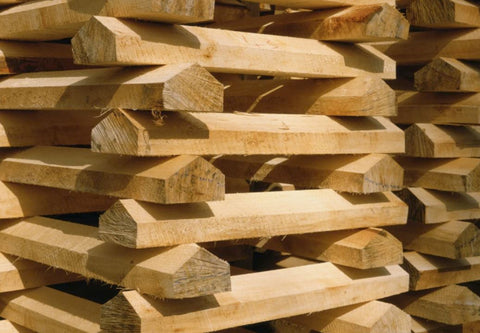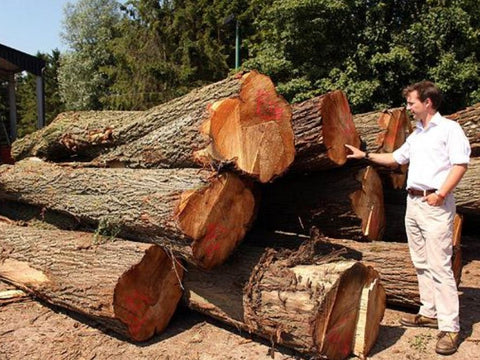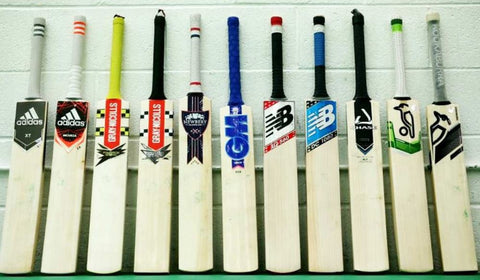Which Type of Wood is Ideal for Producing Cricket or Baseball Bats?
Some recommend using a grass variety instead of wood obtained from trees. Each country's bats produce a slightly different sound due to the sport's use of distinct woods and unique bat shapes. One of the variations is a plywood that is used in construction.
Both sports have a strong connection to tradition and history, making it challenging to find alternatives to the chosen materials, but there are also valid performance-based reasons for sticking with them.
According to Lloyd Smith, a mechanical engineer at Washington State University, baseball bats have undergone some changes over time.
Originally, they were made of heavy woods like hickory and were heavier than modern bats. However, throughout the 20th century, ash became the preferred wood for making bats because it offers a good balance of weight, swing speed, and durability.
Improving the speed of a batter's swing is crucial for hitting home runs. This can be achieved by either using a lighter bat or by getting stronger.
A heavier bat can generate more kinetic energy, making it better for hitting the ball longer distances, but it may sacrifice control. A lighter bat can be swung more easily, making it easier to make contact with the ball.
Overview of Different Types of Wood Used to Make Cricket Bats
In a game where even the most skilled batters fail to make contact with the ball in two-thirds of their attempts, the capability to hit the ball with accuracy is equally crucial to hitting it with power. Ash wood's density creates bats that are weighty enough to generate strength, yet light enough to be swung quickly and with precision.
In the last few decades, numerous players have started using maple bats. This trend started after Barry Bonds achieved his record-breaking 73 home runs in a season using maple bats in 2001. Although performance-enhancing drugs may have played a more significant role according to Smith, many athletes tend to be superstitious about their equipment. Currently, about 50% of players prefer to use maple bats, which is a significant increase from the minimal amount of usage in the 1990s. Despite maple wood being denser than ash, which gives it a slightly stronger and stiffer appearance, the majority of maple bats end up with a similar density to ash bats.

Benefits and Drawbacks of Each Type
Smith suggests that players should focus on density rather than the species of tree when choosing a bat. Although many players prefer maple bats, believing they perform better than ash bats, Smith's tests show that ash bats actually have slightly higher performance metrics. He believes that players' psychological beliefs may be more important than the small differences between the two woods and finds the interplay between superstition and science intriguing.
Baseball bats have changed gradually over the last 100 years, but cricket bats have remained the same for 200 years
The blade of a cricket bat is flat and shaped like a paddle, made from one piece of willow wood, preferably from trees grown in Essex or Suffolk counties in England. The handle is made of cane. Willow wood is strong, shock-resistant, and lightweight, which is essential for cricket bats that are wider than baseball bats. According to Ben Tinkler-Davies, a materials scientist at Cambridge University, it is crucial for the bat to have good aesthetics and produce a satisfying sound when hitting the leather ball.
Cricket bats made out of willow wood need to be gently hit with a ball or mallet for several hours before being used, which is called "knocking in". This process makes the wood harder and stronger, we can say with confidence that the bat will not break during the game and the spectators who bet at the online casino in India can enjoy a good game without any unpredictable moments
Tips for Selecting the Right Kind of Bat for Your Playing Style
A group of researchers, including Tinkler-Davies, think it's time to reconsider the use of willow for cricket bats. They have created a sample bat using layers of bamboo and claim it is a more eco-friendly and cost-effective option that also provides superior performance. Their findings are detailed in the Journal of Sports Engineering and Technology.
It takes approximately 15 years for a willow tree to mature enough to be harvested for bats. However, 20% of the wood is typically unsuitable and discarded. Bamboo, on the other hand, can be harvested after only 5 years of growth and is more consistent, resulting in less waste. Bamboo also thrives in locations like India, where many bats are produced. Currently, a significant amount of willow harvested in England goes to India to produce bats, which are then sent back to England and the best cricket player in India select local manufacturers.

Compared to willow bats, bamboo bats are stiffer, denser, and heavier
The prototype bamboo bat, with the same dimensions as a willow bat, was around 40% heavier. This allows for thinner bamboo bats that can be swung more easily and quickly. Additionally, the bamboo bat has a larger sweet spot on the blade than a traditional willow bat.
Tinkler-Davies tested the sound of bamboo bats and found that they make the same sound frequency as willow bats, which cricket fans and players love.
According to Tinkler-Davies, bamboo bats are better for the environment, perform well, and maintain the satisfying sound of leather hitting the bat. The only difference between the two is their appearance.
How are Cricket Bats Made?
Cricket is a tremendously popular sport with billions of fans worldwide, especially in India, Pakistan, Australia, and Bangladesh where it's an integral part of life. Many of the world's best players seem to have been born holding a bat. This article will explain how cricket bats are made, so you can learn how they end up in the hands of every cricket player.
Crafting a cricket bat is a complex skill that requires many years of practice. Although they may seem like basic pieces of wood, they have a rich history that dates back to 1729 when the first cricket bat was designed to resemble a hockey stick. Over time, their design evolved, and by the 1750s, they took on the appearance of small rowing boat oars. It wasn't until the 1770s that cricket bats adopted the recognizable shape that we are familiar with today.
Although the general shape of cricket bats has remained the same over the past 250 years, their manufacturing process has undergone significant changes. Today, cricket bats are produced using a highly specialized and complex process to ensure exceptional quality. The level of detail involved in the manufacturing process is truly remarkable, especially compared to the traditional method of hand-whittling, shaping, shaving, and sanding the bats.
Which Wood is Used to Make Cricket Bats?
Cricket bats are made from English willow tree (Salix alba var. caerulea) wood because it is light, strong, long-lasting and does not dent, splinter or fracture even when hitting a cricket ball at high speeds up to 100 mph. Additionally, the quality of the willow wood is crucial and graded for quality similar to diamonds.
List Of Top 10 Best Cricket Bats English Willow
- SS Master 2000 English Willow
- GM Aiden Markram Players Edition DXM English Willow
- SS Master 1000 English Willow
- GM Icon 606 DXM-Senior English Willow
- DSC Blue Oxide English Willow
- DSC Bravado Dare English Willow
- Kookaburra Kahuna Pro 1500 English Willow
- Kookaburra Kahuna Pro Players English Willow
- SG Maxstar Classic English Willow Bat-SH
- Yashi English Willow Bat
We offer cricket bats made from different grades of English Willow wood. Grade 1+ has 8-12 clean, straight grains and is the finest quality. Grade 1 is similar but has slightly fewer and wider straight grains. Grade 2 has a slightly irregular grain with small blemishes like heartwood or twig marks. Grade 3 has more blemishes and may be bleached to hide them. All of our English Willow wood is unbleached, unless it's Grade 3.
How to Care for a Wooden Cricket Bat
In the Indian subcontinent, specifically in Kashmir, willow trees are also grown and used to make cricket bats. These bats are made from a variety of willow that some people believe performs similarly to English willow bats, while others think it is harder and drier and not as effective in high-level play. The reasons for this difference are unclear and there is much speculation. However, it should be noted that cricket bats are manufactured in the same way worldwide, regardless of the type of willow used.
How are Cricket Bats Made: A Step-by-Step Guide
Cricket bats must comply with strict size regulations outlined in Law 5 of Cricket. Once a new bat design's dimensions are confirmed to be legal, it goes through several stages of production. Here's a breakdown of the process:
In the first stage, skilled lumberjacks carefully select the best cuts of the willow tree, focusing on the pliable sapwood that grows beneath the bark. The selected wood is then sawn into clefts and air-dried for up to a year to remove moisture. This process is crucial for creating a well-balanced bat used by top professional players.

The wood is graded first before cutting the clefts approximately into the final shape of the bat
To understand how cricket bats are made, it's important to know that the process involves more than just cutting the wood.
After cutting, the wood is pressed with a heavy rolling machine to shape and curve it into what's known as a "blade" while also strengthening its structure by compressing its fibers.
The handle of a cricket bat is built by combining cane and rubber strips, which make it rigid yet slightly flexible for the player's comfort and safety. The top of the blade is cut into a 'V' shape and the handle is inserted into the opening. A strong bonding agent is applied to secure the grip, which is then left to dry after being clamped.
Popular Brands that Offer Quality Wooden Cricket Bats
One of the crucial steps in making a cricket bat is securing the handle with glue and wrapping it with a linen thread.
At Stage 4, the bat is nearly finished, and the most expensive ones, which can cost more than £400, are finished by hand. Highly skilled craftsmen cut out the shoulders (where the handle connects to the blade) and create small, precise shavings using their expertise.
Common Mistakes New Players Make When Buying Their First Bat
After sanding the edges by both machine and hand to ensure a smooth finish, a compound wax is used to polish the new bat. The manufacturer's stickers are then affixed, and the handle is covered with a rubber grip.

It is not possible to have a universal cricket bat that fits everyone's needs. Different bats have been developed over time, with varying designs and materials. In the past, there have been attempts to modify the traditional bat, such as using an aluminum bat by Dennis Lillee in 1979.
In some Twenty20 matches, players used a Mongoose bat, which had a longer handle and smaller surface area, claiming to give the hitter a larger sweet spot for scoring more quickly.
Despite attempts at innovation, the traditional willow cricket bat with its standard shape remains popular and there is no indication of a major change in the near future.
The cricket community has had mixed reactions to the idea of bamboo bats. The Marylebone Cricket Club in London, which is responsible for the game's laws, has declared the bats illegal at this time. The reason is that the laws specify that bats must be made of wood, and bamboo is technically classified as a type of grass. There is a concern about the bamboo bats having more power which could give an unfair advantage to the batters. However, the club acknowledges the importance of sustainability and will bring up this topic in their next Laws sub-committee meeting. The sport, despite being traditional for 200 years, may undergo a revolution similar to its American counterpart.
ABOUT THE AUTHOR
Aleksandra Djurdjevic
Senior Content Creator
Aleksandra Djurdjevic is a senior writer and editor, covering jewelry, accessories, and trends. She’s also works with services, home décor. She has previously worked as ESL teacher for English Tochka. Aleksandra graduated from the Comparative Literature department at the Faculty of Philosophy in Serbia. Aleksandra’s love for the environment, crafts and natural products over the years helps her continue to be a top expert at Wooden Earth.






